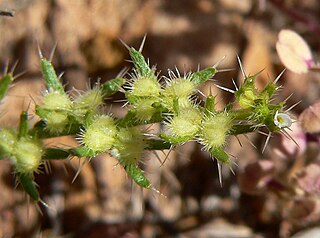The Trinity bristle snail is a species of medium-sized land snail, a terrestrial pulmonate gastropod mollusc in the family Monadeniidae.
A tab-separated values (TSV) file is a simple text format for storing data in a tabular structure, e.g., database table or spreadsheet data, and a way of exchanging information between databases. Each record in the table is one line of the text file. Each field value of a record is separated from the next by a tab character. The TSV format is thus a type of the more general delimiter-separated values format.

The Iris flower data set or Fisher's Iris data set is a multivariate data set introduced by the British statistician and biologist Ronald Fisher in his 1936 paper The use of multiple measurements in taxonomic problems as an example of linear discriminant analysis. It is sometimes called Anderson's Iris data set because Edgar Anderson collected the data to quantify the morphologic variation of Iris flowers of three related species. Two of the three species were collected in the Gaspé Peninsula "all from the same pasture, and picked on the same day and measured at the same time by the same person with the same apparatus".

Echeveria setosa, the Mexican fire cracker, is a species of flowering plant in the Crassulaceae family, native to semi-desert areas of Mexico and common throughout Puebla.
Chloristola is a monotypic moth genus in the family Geometridae. Its only species, Chloristola setosa, is known from Borneo and Malaysia. The type locality is Gunung Mulu National Park. Both the genus and species were first described by Jeremy Daniel Holloway in 1996.

Pectocarya setosa, known by the common names moth combseed and round-nut pectocarya, is a species of flowering plant in the borage family.
Pellilitorina setosa is a species of sea snail, a marine gastropod mollusk in the family Littorinidae, the winkles or periwinkles.
Orchestina setosa is a spider species found in France and Italy.
Mahonia setosa is a shrub in the Berberidaceae described as a species in 1908. It is endemic to China, known from the provinces of Sichuan and Yunnan.

Iris setosa, is a species in the genus Iris, it is also in the subgenus of Limniris and in the Iris series Tripetalae. It is a rhizomatous perennial from a wide range across the Arctic sea, including Alaska, Maine, Canada, Russia, northeastern Asia, China, Korea and southwards to Japan. The plant has tall branching stems, mid green leaves and violet, purple-blue, violet-blue, blue, to lavender flowers. There are also plants with pink and white flowers.
Sophronica is a genus of longhorn beetles of the subfamily Lamiinae, containing the following species:

Parasagitta setosa is a small arrow worm in the family Sagittidae, previously referred to as Sagitta setosa. It is native to the northeastern Atlantic Ocean, the North Sea and the Mediterranean Sea, and also occurs in the Baltic Sea and the Black Sea.
Crepis setosa, the bristly hawksbeard, is a European species of flowering plant in the daisy family. It has become naturalized in North America and occurs Washington, Oregon, California, Idaho, Montana, Texas, Arkansas, Missouri, Tennessee, Wisconsin, Ohio, Pennsylvania, New York, Connecticut and Vermont.
Sophronica rufobasiantennalis is a species of beetle in the family Cerambycidae. It was described by Stephan von Breuning in 1948. It contains the varietas Sophronica rufobasiantennalis var. ovalis.
Sophronica rufulescens is a species of beetle in the family Cerambycidae. It was described by Stephan von Breuning in 1940. It feeds on the Monterey Pine.
Sophronica subdivisa is a species of beetle in the family Cerambycidae. It was described by Stephan von Breuning in 1940.
Sophronica angusticollis is a species of beetle in the family Cerambycidae. It was described by Per Olof Christopher Aurivillius in 1928. It is known from Somalia, Ethiopia, Tanzania, and Kenya.
Sophronica amplipennis is a species of beetle in the family Cerambycidae. It was described by Pascoe in 1888.
Aethrikos is a monospecific genus of velvet worm containing the single species Aethrikos setosa. It is found in New South Wales, Australia.

Corymbia setosa, commonly known as the rough leaved bloodwood and the rough leaved range gum, is a member of the genus Corymbia native to northern Australia.







